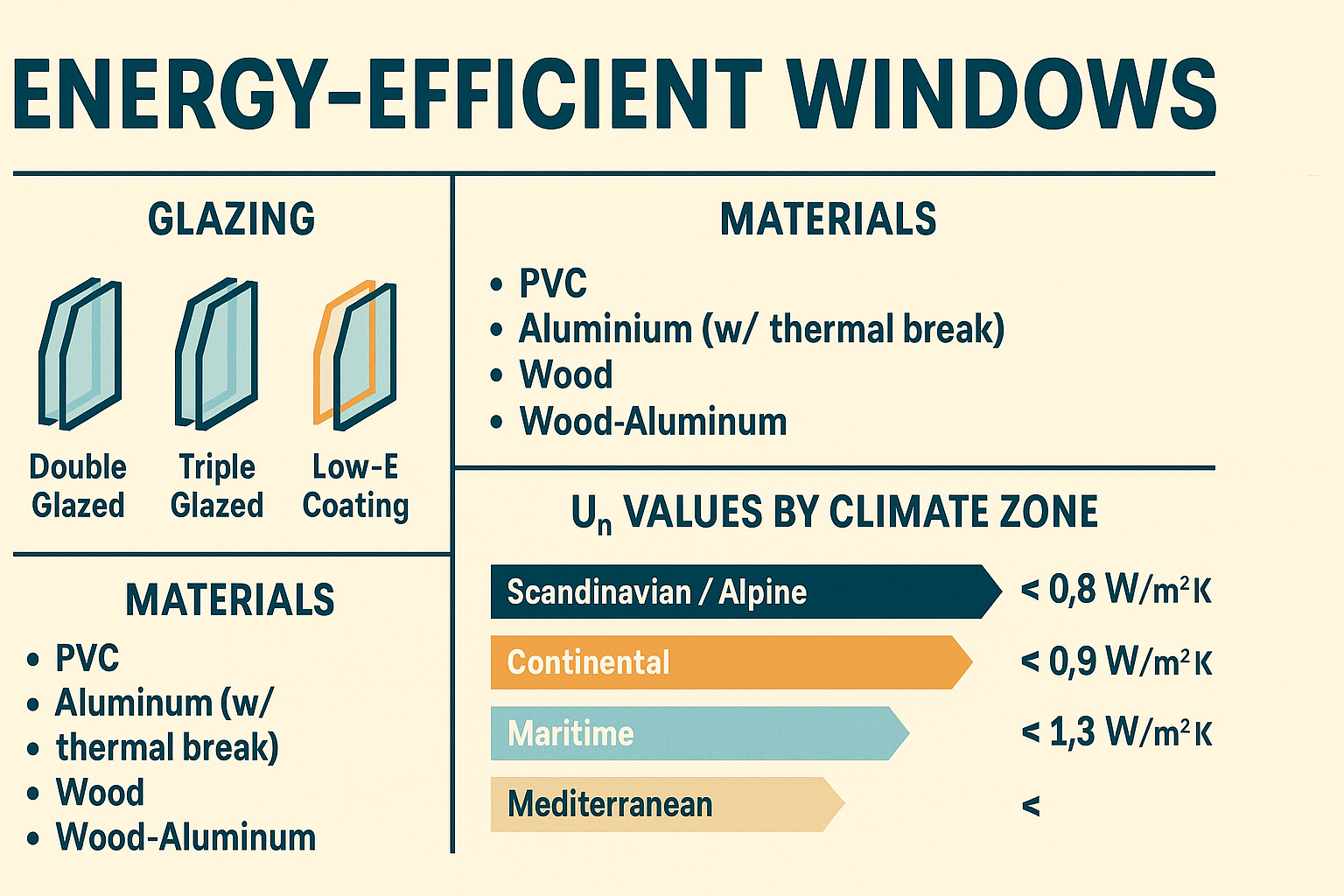
The Best Windows for European Climates: Your Ultimate Buying Guide
Choosing the right windows isn’t just about aesthetics — it’s a strategic decision that directly affects your home’s comfort, energy bills, acoustic insulation, and long-term durability. In a continent as climate-diverse as Europe, one-size-fits-all solutions just don’t cut it. The right choice of glazing, profile material, and installation technique can dramatically improve energy efficiency and reduce your carbon footprint — while also boosting your home’s visual appeal and resale value.
This guide goes beyond the basics to help you choose wisely — tailored to your specific climate zone.
🌍 Why Climate Matters
Europe spans multiple climate zones, from the icy conditions of Scandinavia and the Alps, to the warm and sunny Mediterranean coastlines. Each of these regions presents unique environmental challenges that windows must be able to withstand.
For example, homes in Norway need windows that can resist snow accumulation, freezing temperatures, and high winds. Meanwhile, a villa in southern Italy must prioritize sun protection and airflow. Coastal regions deal with humidity, storms, and salt air, which can damage window frames over time. Understanding your local climate zone is the first step in making an informed choice that protects your comfort and your investment.
🪟 Climate-by-Climate Window Recommendations
Each climate zone in Europe requires a slightly different approach to window construction and insulation. Here’s a quick breakdown:
| Climate Zone | Ideal Window Type |
|---|---|
| Scandinavian / Alpine | Triple-glazed panes, warm-edge spacers, and tightly sealed, insulated frames. These regions face extended winters, high winds, and large temperature fluctuations, requiring maximum thermal protection and structural integrity. |
| Continental | Triple glazing is still recommended, but with an added focus on airtightness and resistance to seasonal humidity and UV. Heavy-duty uPVC or alu-clad wood profiles perform well here. |
| Maritime | Salt air, moisture, and gusty winds demand corrosion-resistant frames (e.g., aluminum with powder coating) and durable seals. Sound insulation also plays a key role due to wind and ocean noise. |
| Mediterranean | Double glazing is often sufficient, provided it’s paired with solar control coatings and effective shading solutions. Lightweight frames like aluminum or PVC work best for maintaining airflow and thermal balance. |
🛠️ Materials: Pros & Considerations
Choosing the right frame material is just as important as selecting the glazing. Here are the most popular choices in Europe:
- PVC (uPVC):
Affordable, low-maintenance, and naturally insulating. PVC is especially effective in temperate and continental climates. Look for multi-chamber profiles (ideally Class A) with reinforced steel cores for better performance and durability. - Aluminium (with thermal break):
Offers a sleek, modern appearance and excellent structural strength. Without a thermal break, however, aluminum is prone to thermal bridging. Always choose profiles with insulated cores if you’re in a colder climate. - Wood & Wood-Aluminium Composites:
A premium option offering high insulation and a timeless look. Engineered wood like Meranti is resistant to warping and moisture, while alu-clad wood combines interior warmth with exterior weather protection. - Steel:
Ultra-slim and extremely strong, but naturally less insulating. Modern steel windows with advanced thermal breaks and specialized glazing can meet current energy standards — often used in historic renovations and industrial-style architecture.
📏 Key Technical Features
To meet the energy and comfort demands of today’s homes, windows must include a combination of technical enhancements:
- Glazing:
Triple-glazed glass filled with argon or krypton gas is the gold standard for northern and continental Europe. This provides superior U-values (≤ 0.8 W/m²K) ideal for passive house standards. - Low‑E Coatings:
Low-emissivity coatings on the glass reflect heat back into the room during winter, and protect interiors from UV rays year-round. In sunny climates, solar control versions can reduce overheating. - Warm Spacers & Gaskets:
These help prevent condensation and thermal bridging between panes, ensuring consistent comfort and long-lasting seals. - Profile Class & Chambers:
A multi-chamber frame (7–8 chambers) in Class A offers maximum rigidity and insulation. The thicker the walls, the better the window performs in thermal and acoustic terms. - Frame Durability:
Especially critical in regions with extreme temperatures, moisture, or salt exposure. Reinforced profiles and corrosion-resistant coatings help maintain performance over time.
💶 Investment vs. Benefits
Yes, energy-efficient windows often come with a higher initial price tag — especially when you go for triple glazing or composite frames. But that investment quickly pays for itself through:
- Lower heating and cooling bills
- Improved thermal and acoustic comfort
- Reduced load on HVAC systems
- Long-term durability with minimal maintenance
- Higher property value and better aesthetics
- Eligibility for energy-efficiency grants and subsidies in many European countries
If you view windows not as a purchase, but as an energy-saving tool — the decision becomes much easier.
✅ Checklist Before Buying
Before you place an order or call your installer, run through this checklist:
- Identify your climate zone
Use the recommendations above to guide your glazing and frame choices. - Determine your energy goals
Are you targeting passive standards or just basic comfort? Choose U-values accordingly. - Pick the right frame material
Consider aesthetics, maintenance, cost, and performance in your region. - Ensure profile class & spacers meet high standards
Ask for certificates or product datasheets if needed — don’t rely on appearance alone. - Think about extras
Solar protection, noise reduction, rain guards, smart glass, and shutters all add long-term value. - Hire certified installers
Even the best window will underperform if installed poorly. Go with a trusted, experienced team.
🔗 Suggested Internal Links from www.tampawindowtint.org
- Energy‑Efficient Windows Installation Guide – covers warm installation and airtight sealing
- Window replacement step by step – ideal for upgrades after selecting materials
- How to measure windows? – ensures precise fit for chosen frames
- 7 most common window installation mistakes – avoid pitfalls that undermine energy performance

